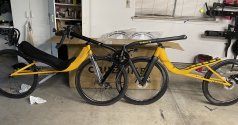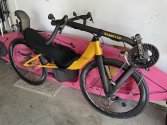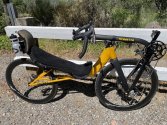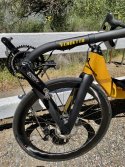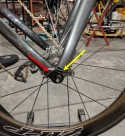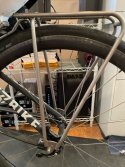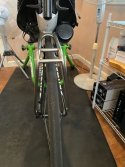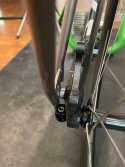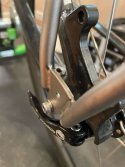chicorider
Zen MBB Master
I bought my first Cruzbike (and first recumbent) in 2015. It was one of the last of the gold Vendettas, known as the V.2, before the red V20 came out. But after retrofitting the V20 boom and chainstay, as well as the carbon fiber seat pan, I took to calling my V.2 a V20. Since then I have owned a S30, Quest, and S40, in that order. The S40 replaced the Quest, which I sold, and the S30/S40 combo proved to be too redundant. Once I fit a Tubus Airy ti rear rack to the S30, it won out over the S40, which found a nice new home in Kansas. The bike that remained constant was that gold V20--the one that I would never part with...unless Cruzbike released a significant update.
I am a high school English teacher who decided back in December that it was time to retire (as I write this, I have three days left). Since then I have been building my retirement bikes: an Ibis Ripmo V.2 for mountain biking gnar, a generic Chinese 29er carbon fiber hardtail built with high-end parts for gravel--a bike that has blown my mind, my CB S30 Jack-of-all-trades, and this new V20c road rocket. "Retirement bikes" translates to "you are about to be making a bit less money, so build your best bikes that you can ride for a long time now." I mention this because it gets to the question of motivation. Should a person new to Cruzbike and eying the Vendetta pony up for the V20c? Most likely yes, if cost is not much of an issue. This version performs like a boss and it is up to date. (If cost is prohibitive, or you are unsure whether or not you will take to the bike, then a used V20 would make more sense. But if you buy a used V20 purely out of uncertainty and you love it, then you're going to wonder how much better the V20c is. Then again, you could probably sell that used V20 for almost what you paid for it and put those funds toward a V20c. It's like you are renting that used V20, just to make sure that you like it before making that more significant investment in a V20c).
So, what about it? The V20c is not night-and-day better than the V20, but it is better. Compared to the V.2, the geometry is more planted. Robert Holler called the new geometry "sublime." For me, it feels both more stable and more agile--more confidence-inspiring in the corners. The carbon front end, combined with the thru axles, creates greater drivetrain unity while smoothing out the overall ride. I've noticed that I have been dropping down to the next smaller cog on familiar routes, and this bike gobbles up rollers better than the V20, which was already really good at roller-gobbling. I appreciate the flat mount disc brake tabs, which gave me the push to finally move from caliper brakes to discs. You can put disc brakes on the V20, but the flat mount tabs seem more up to date.
Is the V20c lighter? A little, but by itself it isn't enough justification to move up from a V20.
But I will say that the V20c sure is sexy looking!
Side notes: I mentioned the V20c's "smoothness." These impressions are not for the full bike build, as shipped by Cruzbike. I set the aluminum wheels and Microshift 11 speed system aside right away and built the frameset up around a new SRAM Red 11 speed group, and Light Bicycle carbon wheels that I built myself (I've been building my own wheels for about 30 years. I love it!). The smoothness of this new ride might come partly from my move from Schwalbe Pro One 25c tubeless tires to Pro One 30c tubeless tires. I wanted to go with 28c, but with pandemic supply-chain issues, they just were not available at a price that didn't bring the word "rapacious" to mind. The 30c size, however, was affordable and available, so I went with those, hoping that what I'd been hearing about the benefits of wider tires were true. It seems this was kismet in action. I love these 30c tires. The rims I used were a little wider than my previous rims, and these new tires fit them perfectly, creating a nice, straight line from sidewall to rim. I can run lower pressures and have wheels that run as fast as before (or faster), while also smoothing out road chatter at least enough to notice the difference. Pair that with the more unified front end, and the V20c hauls balls.
For the vertically challenged: I stand 5'5" on a good day, with proportionally short legs, and have been using the short 16-inch aluminum chainstay on my V20 and S30. When I found out that the V20c would not come with a short chainstay option, I was concerned that the standard medium size would put my feet too high and place the handlebar in my belly, which was the case with the medium chainstays on both the V20 and S30. It turns out that the new medium chainstay is a little shorter, and perhaps combined with the geometry update, the fit is great. My feet are a couple inches higher, which took me no time at all to acclimate to, and I think I'm a little more aero than I was before. Looking at the chainstay/fork juncture, I don't think I could go much shorter, but I am relieved that this fit concern has worked out. But what if it didn't? In the weeks of waiting, I contacted a selection of carbon fiber fabricators to find out if it would be possible to shorten this chainstay. A few of them said, "Probably so," but that they'd need to look at the actual part first. I was prepared to take this route, but am truly relieved that I don't have to.
When Ibis released the Ripmo V.2, reviewers said that the V.2 was better than the V.1. But they also said that the V.2 wasn't necessarily or automatically better enough for V.1 owners to make the switch. I was not V.1 owner, so buying the V.2 made sense. The V20c is a similar proposition. After seven years, I was ready for an upgrade/update, and in these pre-retirement months, I had the funds to pursue it. Mostly a no-brainer. But if you are riding and loving a recent model V20, and aren't flush with cash, I'd say keep riding it. But if you are flush with cash, and can afford some luxury, you will most likely notice subtle performance differences between the V20 and V20c, as I have.
I am a high school English teacher who decided back in December that it was time to retire (as I write this, I have three days left). Since then I have been building my retirement bikes: an Ibis Ripmo V.2 for mountain biking gnar, a generic Chinese 29er carbon fiber hardtail built with high-end parts for gravel--a bike that has blown my mind, my CB S30 Jack-of-all-trades, and this new V20c road rocket. "Retirement bikes" translates to "you are about to be making a bit less money, so build your best bikes that you can ride for a long time now." I mention this because it gets to the question of motivation. Should a person new to Cruzbike and eying the Vendetta pony up for the V20c? Most likely yes, if cost is not much of an issue. This version performs like a boss and it is up to date. (If cost is prohibitive, or you are unsure whether or not you will take to the bike, then a used V20 would make more sense. But if you buy a used V20 purely out of uncertainty and you love it, then you're going to wonder how much better the V20c is. Then again, you could probably sell that used V20 for almost what you paid for it and put those funds toward a V20c. It's like you are renting that used V20, just to make sure that you like it before making that more significant investment in a V20c).
So, what about it? The V20c is not night-and-day better than the V20, but it is better. Compared to the V.2, the geometry is more planted. Robert Holler called the new geometry "sublime." For me, it feels both more stable and more agile--more confidence-inspiring in the corners. The carbon front end, combined with the thru axles, creates greater drivetrain unity while smoothing out the overall ride. I've noticed that I have been dropping down to the next smaller cog on familiar routes, and this bike gobbles up rollers better than the V20, which was already really good at roller-gobbling. I appreciate the flat mount disc brake tabs, which gave me the push to finally move from caliper brakes to discs. You can put disc brakes on the V20, but the flat mount tabs seem more up to date.
Is the V20c lighter? A little, but by itself it isn't enough justification to move up from a V20.
But I will say that the V20c sure is sexy looking!
Side notes: I mentioned the V20c's "smoothness." These impressions are not for the full bike build, as shipped by Cruzbike. I set the aluminum wheels and Microshift 11 speed system aside right away and built the frameset up around a new SRAM Red 11 speed group, and Light Bicycle carbon wheels that I built myself (I've been building my own wheels for about 30 years. I love it!). The smoothness of this new ride might come partly from my move from Schwalbe Pro One 25c tubeless tires to Pro One 30c tubeless tires. I wanted to go with 28c, but with pandemic supply-chain issues, they just were not available at a price that didn't bring the word "rapacious" to mind. The 30c size, however, was affordable and available, so I went with those, hoping that what I'd been hearing about the benefits of wider tires were true. It seems this was kismet in action. I love these 30c tires. The rims I used were a little wider than my previous rims, and these new tires fit them perfectly, creating a nice, straight line from sidewall to rim. I can run lower pressures and have wheels that run as fast as before (or faster), while also smoothing out road chatter at least enough to notice the difference. Pair that with the more unified front end, and the V20c hauls balls.
For the vertically challenged: I stand 5'5" on a good day, with proportionally short legs, and have been using the short 16-inch aluminum chainstay on my V20 and S30. When I found out that the V20c would not come with a short chainstay option, I was concerned that the standard medium size would put my feet too high and place the handlebar in my belly, which was the case with the medium chainstays on both the V20 and S30. It turns out that the new medium chainstay is a little shorter, and perhaps combined with the geometry update, the fit is great. My feet are a couple inches higher, which took me no time at all to acclimate to, and I think I'm a little more aero than I was before. Looking at the chainstay/fork juncture, I don't think I could go much shorter, but I am relieved that this fit concern has worked out. But what if it didn't? In the weeks of waiting, I contacted a selection of carbon fiber fabricators to find out if it would be possible to shorten this chainstay. A few of them said, "Probably so," but that they'd need to look at the actual part first. I was prepared to take this route, but am truly relieved that I don't have to.
When Ibis released the Ripmo V.2, reviewers said that the V.2 was better than the V.1. But they also said that the V.2 wasn't necessarily or automatically better enough for V.1 owners to make the switch. I was not V.1 owner, so buying the V.2 made sense. The V20c is a similar proposition. After seven years, I was ready for an upgrade/update, and in these pre-retirement months, I had the funds to pursue it. Mostly a no-brainer. But if you are riding and loving a recent model V20, and aren't flush with cash, I'd say keep riding it. But if you are flush with cash, and can afford some luxury, you will most likely notice subtle performance differences between the V20 and V20c, as I have.

